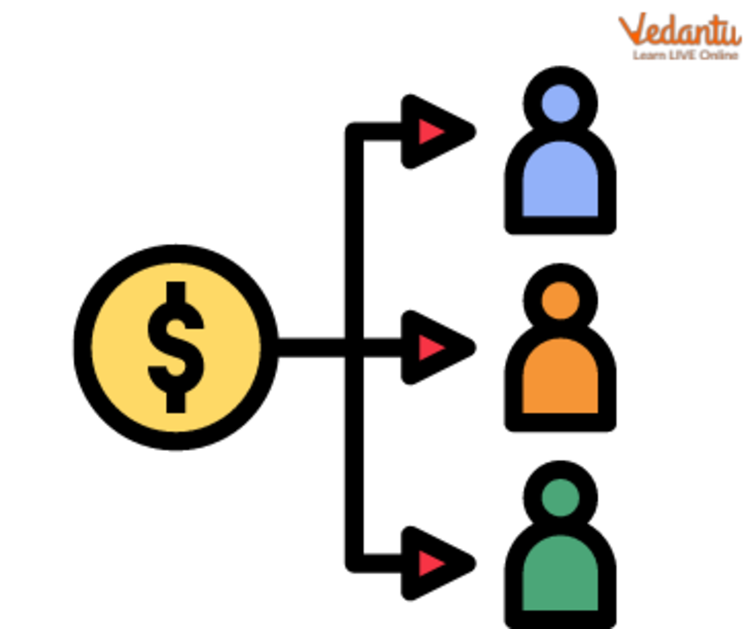




What is the Pro Rata Allotment of Shares?
Pro rata, in Latin means "in proportion." It's a catch-all phrase for any situation in which something is divided into parts proportional to people's total stake. To rephrase, "pro rata" means that each person receives an amount equal to their part of the total.
Shares are allocated pro-rata when the total number of shares requested is less than the total number of shares available. An oversubscription of shares pro rata allotment means the corporation will apply any additional funds to the application stage and subsequently to the calls. After allocation and applicant contact, the balance is returned. The firm promotes allocation in all major journals.

Meaning of Pro Rata for Allotment for Shares.
Pro rata Allotment of Shares Meaning
The Latin phrase "pro rata" is frequently used to indicate a fair distribution of resources. It implies roughly "in proportion," or via a system where everything being allotted is split fairly. For example, simple pro-rata allotment of shares meaning is allocating a certain sum to each recipient in proportion to their part of the total. A pro rata computation is helpful in commercial finance but may be used to establish fair shares of any sum. For example, the pro rata allotment of shares method is applied in the insurance industry to calculate the premium price for coverage that will only cover a portion of the term. Pro rata may also allocate the relevant percentage of a yearly interest charge for a short period.

What do you Mean by Allotment of Shares in Pro rata?
Explanation of Pro Rata Allotment of Shares with help of an Example

Understand the Pro rata Allotment with an Example.
To determine the pro rata share, three factors are used:
The total of verified, possessed, or incurred goods.
Its total amount in circulation (i.e. maximum quantity possible).
The allotted number of connected components is mentioned in the second key point.
Take the hypothetical case of a worker expecting a bonus of Rs 10,000 for the year. Even if the employee quits in the middle of the bonus period, they will earn their proportionate part. This is because they'll be leaving on March 20th. So the bonus is stipulated to be paid according to the number of days performed (including the last day).
The pro rata allocation may be found by dividing the actual quantity by the maximum allowable amount. The number of days worked corresponds to the number of instances of truth in this scenario. In a year without a leap day, the span from January 1 and March 20 consists of 79 days. Also, it's worth noting that 365 days seems to be the absolute limit.
Divide 79 by 365 to get 21.64, which is your proportionate share.
Multiply the proportional share with the associated factor to get the pro rata allocation. The proportional share is Rs 2,164 i.e., (Rs 21.64% x Rs 10,000).
Therefore in case the worker resigned on March 20th, the distribution would be Rs 2,164, which is dependent on the worker's prorated total number of days worked throughout the year.
Difference between an Oversubscription and An Under-subscription

Distinction between Oversubscription and Undersubscription
Read here to know the difference between oversubscription and under subscription:
In the case of oversubscription and pro rata, when more applications are received for securities than available shares, the offering is considered to be oversubscribed.
But in an undersubscribed case, the offering is considered undersubscribed if the demand for securities is lower than the supply.
For the approval, under oversubscribed, shares supplied are fewer than the subscribed. Consequently, some applications need to be denied. But in the case of undersubscribed, there will be no rejections of any applications submitted.
Oversubscribed occurs if investors have an optimistic outlook toward the firm's success in the coming years. Conversely, Undersubscribed happens when shareholders are pessimistic about the company's prospects.
Solved Question
Ques. Arihant Ltd. Co. gives out 100,000 shares of stock with a face value of 10 at a 20% premium on June 1, 2018. These are the ways you can pay:
June 1, 2018: On Application ₹2
July 1, 2018: On Allotment including Premium ₹7
September 1, 2018: On First and final call ₹3
The business gets requests for 285,000 shares. It takes care of them in the following ways:
Those who apply for 25,000 shares get them all.
Pro-rata, the people who asked for 2,25,000 shares get one share for every three shares they asked for.
It turns down the requests for 35,000 shares.
The company gets the full amount as it should. Pass necessary journal entries.
Answer: Journal Entries: In the books of Arihant Ltd.
Working Note
Summary
When there are more applications by potential purchasers of an enterprise's shares than shares offered to the public, this is known as an over subscription of shares. When demand exceeds supply, a corporation may decide to raise share prices and issue more shares to satisfy investors.
The corporation often does not take into account a candidate's repeated applications. As a result, businesses often use the third option. During the stage of share allocation, the issue of accounting for oversubscription is often settled.
FAQs on Oversubscription and Pro Rata: Explained
1. What is an example of a pro-rata basis?
For instance, if a person purchases an insurance policy that is offered at a specific price for an entire year after coverage, that person only joins on for half a year's coverage value. That person would pay the insurance provider on a pro-rata basis, which would amount to half of the value of the complete policy. This would be the case even if the person only signs on it for half a year's coverage value.
2. Is there a distinction between prorated and pro rata?
Because of its literal meaning, "in proportion," the term "pro rata" indicates that whatever is being divided into equal parts. Both "pro rata" and "prorated" mean the same term. Both indicate that, within a larger whole, there is a predetermined place for a particular part.
When paying a part-time worker, some companies adopt the pro rata method. The pro rata method is used here to calculate the fraction of a full-time worker's salary that a part-time worker would get.
3. When to use the pro-rata method?
Pro rata can be used in a variety of contexts. Pro rata is often used when - distributing money to a company's shareholders in the form of dividends, calculating the whole premium for a policy that was only active for a portion of the insurance period, and as a method of determining an employee's hourly wage based on their potential full-time earnings.
It can also be used to target specific regions based on their potential for profit and create a comprehensive project budget that considers several stakeholders' demands.





















